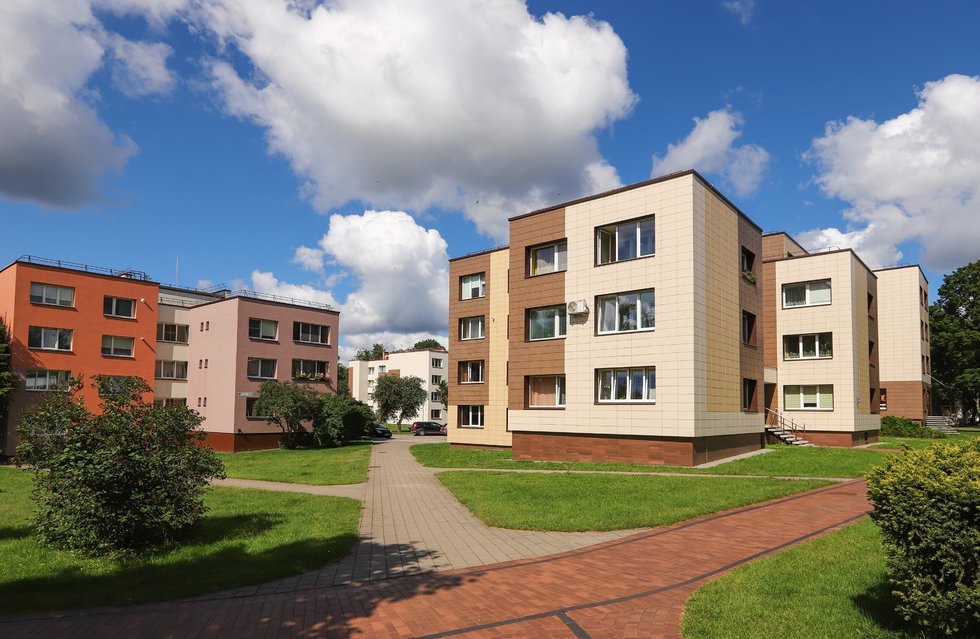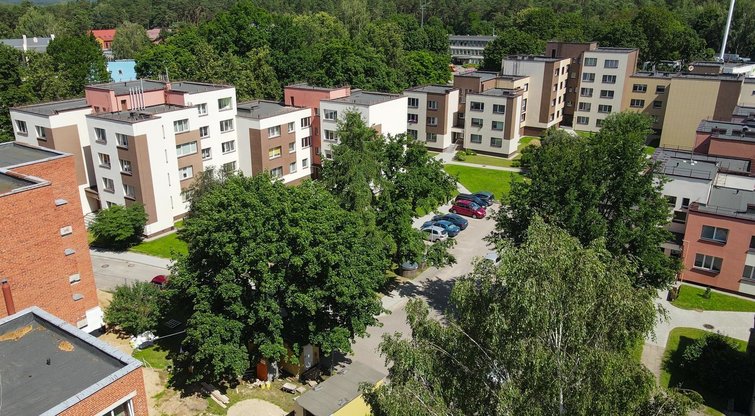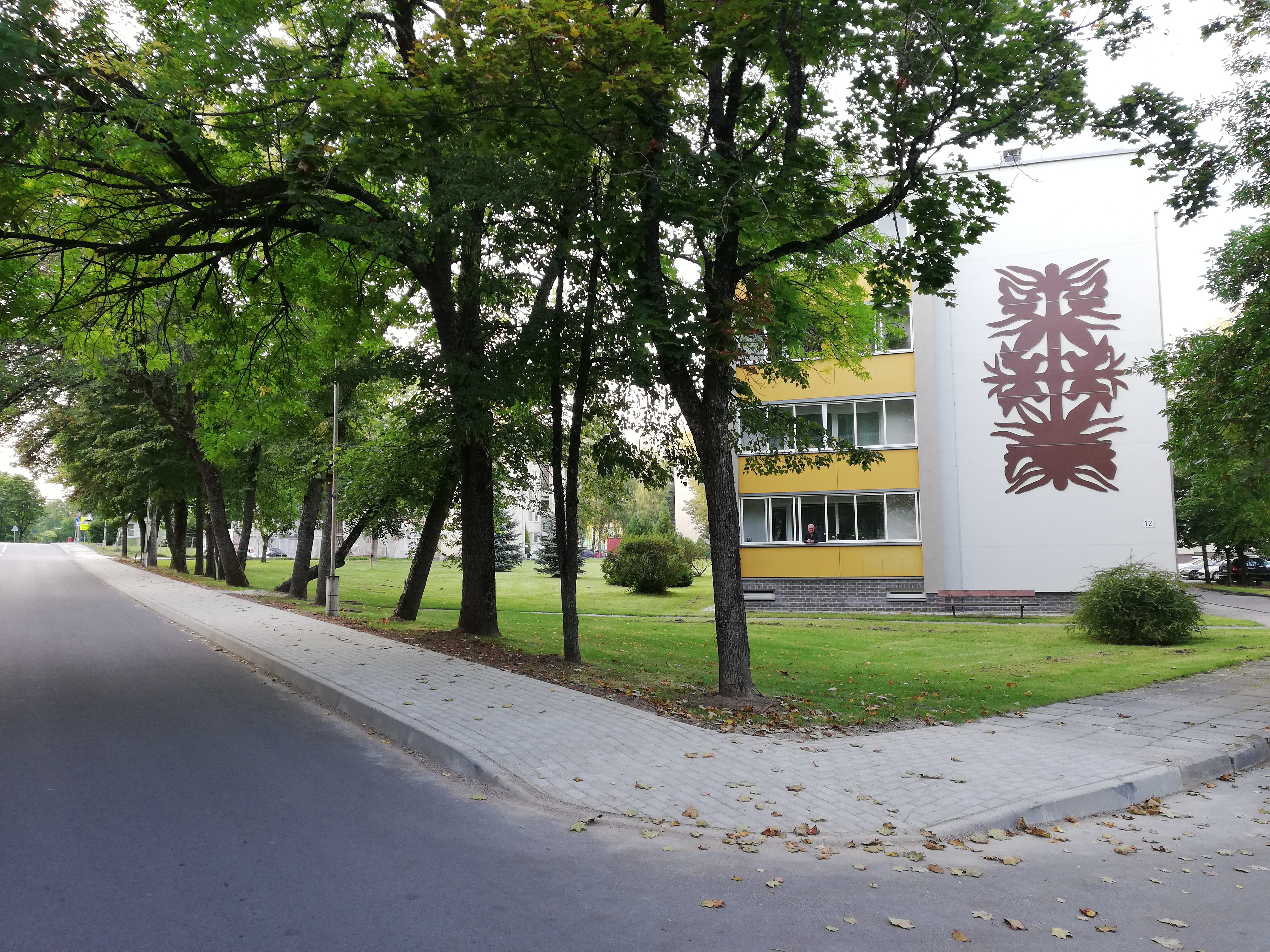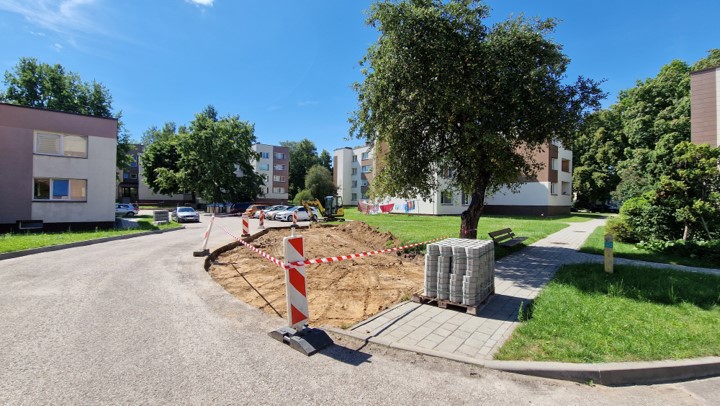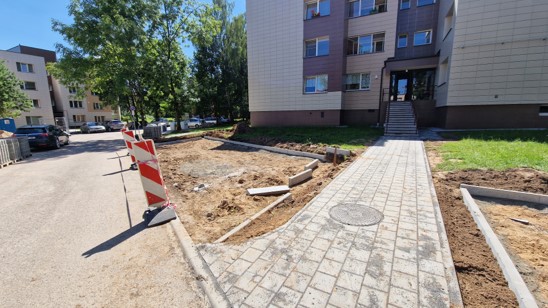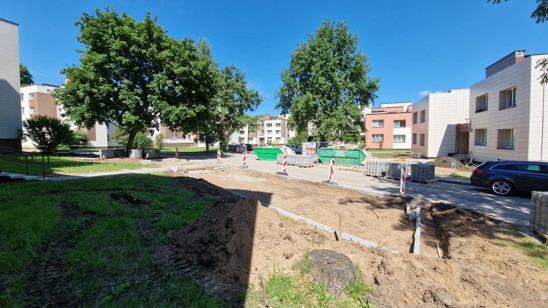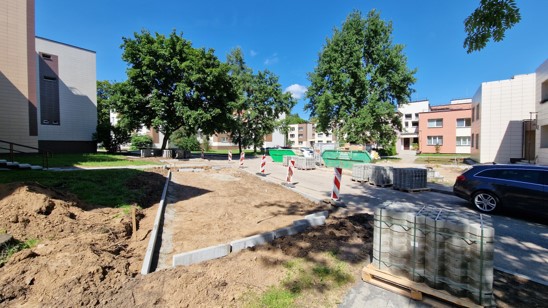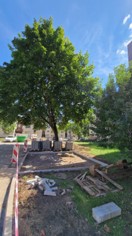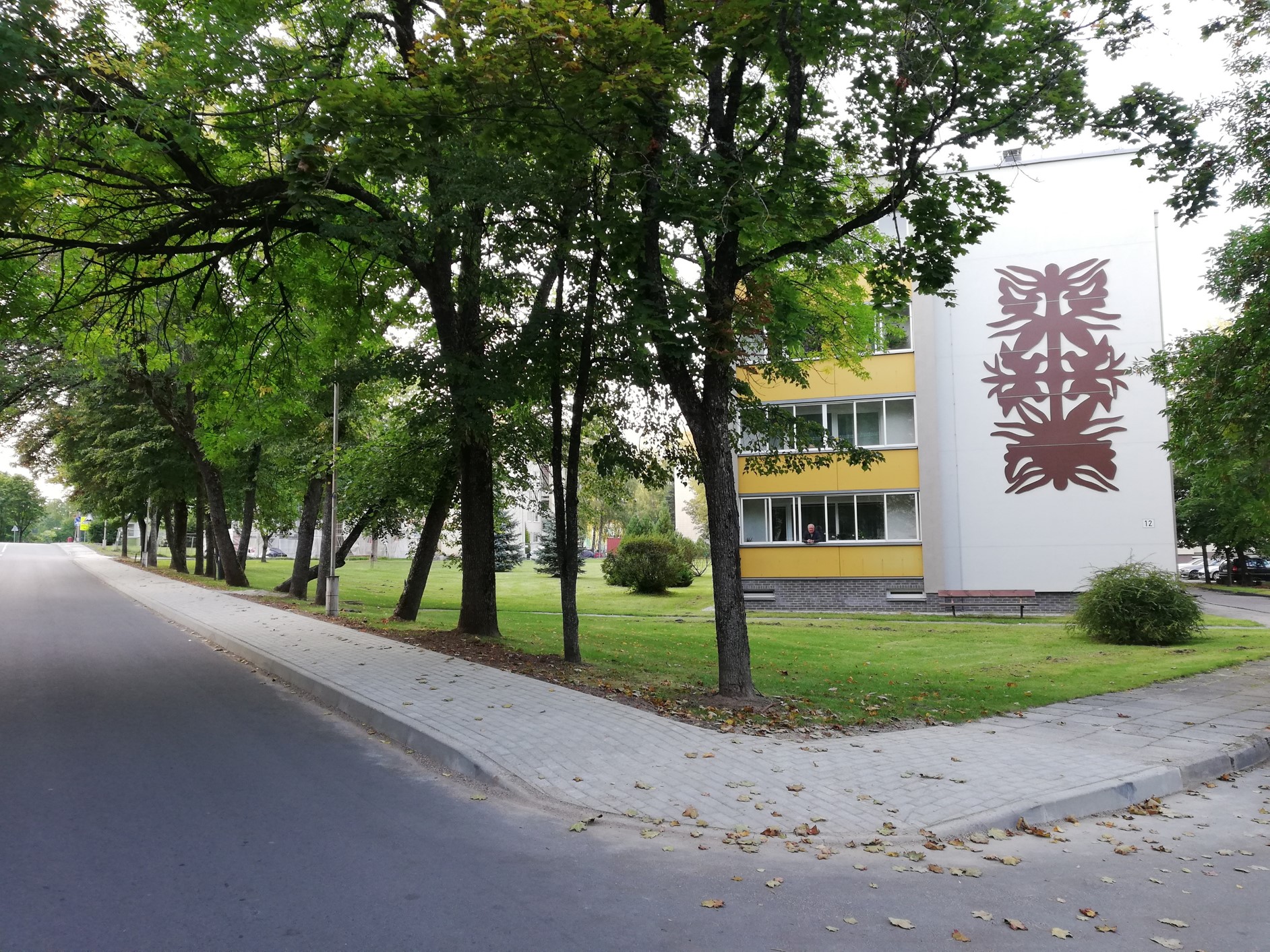Green Birstonas
Green Birstonas by new Bauhaus
Birstonas: Where Green Meets Bauhaus!
A visionary blend of sustainability and modernist design, Birstonas redefines weel-being with eco-friendly architecture, harmonioius public spaces, and a commitment to nature.
Experience a future where Bauhaus siplicity and green inovation create a thriving, balanced community.
A visionary blend of sustainability and modernist design, Birstonas redefines weel-being with eco-friendly architecture, harmonioius public spaces, and a commitment to nature.
Experience a future where Bauhaus siplicity and green inovation create a thriving, balanced community.
Lithuania
Jaunimo g. 2, Birstonas, Lithuania
Completed
Yes
Yes
Yes
No
No
12: Birštono savivaldybė (LT)
Birštonas, a renowned Lithuanian resort town celebrated for its natural beauty and wellness services, has embraced the New European Bauhaus (NEB) initiative. This creative and interdisciplinary movement connects the European Green Deal to our living spaces and experiences, aiming to make green transitions in built environments enjoyable, attractive, and convenient for all.
The primary goal is to transform Birštonas into a sustainable, beautiful, and inclusive destination that harmoniously blends its rich natural resources with innovative design and community engagement.
Specific Objective(s):
Sustainability: Implement eco-friendly practices and infrastructure to promote environmental responsibility.
Aesthetics: Enhance the town's visual appeal through thoughtful design that reflects its cultural heritage.
Inclusivity: Encourage community participation and ensure accessibility for all.
Expected Outcomes:
Enhanced Quality of Life: Improved living conditions for residents through sustainable urban development.
Increased Tourism: Attraction of international visitors seeking unique, eco-friendly destinations.
Community Engagement: Active involvement of locals in the transformation process, fostering a strong sense of ownership and pride.
By integrating the NEB principles, Birštonas aims to become a model for sustainable and inclusive development, offering a harmonious blend of nature, culture, and modern amenities.
The primary goal is to transform Birštonas into a sustainable, beautiful, and inclusive destination that harmoniously blends its rich natural resources with innovative design and community engagement.
Specific Objective(s):
Sustainability: Implement eco-friendly practices and infrastructure to promote environmental responsibility.
Aesthetics: Enhance the town's visual appeal through thoughtful design that reflects its cultural heritage.
Inclusivity: Encourage community participation and ensure accessibility for all.
Expected Outcomes:
Enhanced Quality of Life: Improved living conditions for residents through sustainable urban development.
Increased Tourism: Attraction of international visitors seeking unique, eco-friendly destinations.
Community Engagement: Active involvement of locals in the transformation process, fostering a strong sense of ownership and pride.
By integrating the NEB principles, Birštonas aims to become a model for sustainable and inclusive development, offering a harmonious blend of nature, culture, and modern amenities.
A climate and community friendly resort
Community Engagement
Sustainable Infrastructure
Educational Initiatives
International success story
The quarterly renovation programme in Birštonas resort aimed to improve the energy efficiency of apartment buildings. One of the objectives is not only the modernisation of apartment buildings, but also the involvement of residents in the decision-making process, the improvement of the living environment, the efficient use of energy, the reconstruction of the city's engineering infrastructure and the improvement of the quality of life.
In order to achieve these objectives, Birštonas Municipal Council approved the first Energy Efficiency Improvement Programme for Birštonas City Central Quarter on 22 December 2015. After 3 years, when the programme was reached and exceeded the expectations, on 21 December 2018, the Council approved two more energy efficiency improvement programmes for two more Birštonas districts, in Lelijų and Birštonas streets, where the objectives and targets of the programme were defined. Established Birštonas Housing Energy Saving Agency is doing a great job in engaging the public in climate change programmes, education, and providing assistance to the inhabitants of multi-apartment buildings in the management of projects. Birštonas Municipality is the leading municipality in Lithuania in terms of the percentage of renovated multi-apartment buildings.
Birštonas Municipality has planned and implemented a number of projects related to sustainability, energy efficiency and sustainable development goals. Residents participate in the modernisation programme for multi-apartment buildings, where all multi-apartment buildings are being comprehensively renovated through energy efficiency measures. The annual thermal energy consumption of buildings is significantly reduced and greenhouse gas emissions are reduced. Utilities modernised the infrastructure for heat supply, water supply and sewage treatment, and the city's public infrastructure, such as pedestrian pavements, lighting, and convenient parking lots, was improved.
In order to achieve these objectives, Birštonas Municipal Council approved the first Energy Efficiency Improvement Programme for Birštonas City Central Quarter on 22 December 2015. After 3 years, when the programme was reached and exceeded the expectations, on 21 December 2018, the Council approved two more energy efficiency improvement programmes for two more Birštonas districts, in Lelijų and Birštonas streets, where the objectives and targets of the programme were defined. Established Birštonas Housing Energy Saving Agency is doing a great job in engaging the public in climate change programmes, education, and providing assistance to the inhabitants of multi-apartment buildings in the management of projects. Birštonas Municipality is the leading municipality in Lithuania in terms of the percentage of renovated multi-apartment buildings.
Birštonas Municipality has planned and implemented a number of projects related to sustainability, energy efficiency and sustainable development goals. Residents participate in the modernisation programme for multi-apartment buildings, where all multi-apartment buildings are being comprehensively renovated through energy efficiency measures. The annual thermal energy consumption of buildings is significantly reduced and greenhouse gas emissions are reduced. Utilities modernised the infrastructure for heat supply, water supply and sewage treatment, and the city's public infrastructure, such as pedestrian pavements, lighting, and convenient parking lots, was improved.
The aim of neighbourhood renovation is not only to renovate all apartment blocks and public buildings and to significantly increase the energy efficiency of the buildings, but also to renovate comprehensively and improve the quality of the living environment, to create attractive and comfortable outdoor spaces, to bring greater benefits to the occupants. By fixing the outdated engineering systems of the house, a number of potential emergencies were prevented and the value of the dwelling increased. A great deal of work has been done to involve residents in the renovation process, who were initially sceptical. The Mayoress of Birštonas municipality and administration representatives have been in contact with the residents extensively, presenting the objectives and stages of the block renovation, the progress of the works, and the state-funded modernisation programme for multi-apartment buildings.
Renovated apartment buildings usually achieve high energy efficiency class A - B, which saves at least 40% of the energy costs of maintaining a comfortable temperature in the apartment. The most noticeable change is the aesthetic appearance of the block of flats, which has an impact not only on the house, but also on all surrounding residents. Birštonas Municipality has also contributed to the improvement of the living environment by decorating renovated apartment blocks with original aesthetic paintings of national motifs. The residents' homes have become attractive and distinctive. The modernisation reduces the environmental impact of the renovated house, improves the physical characteristics of the building and its engineering systems, resulting in lower heating costs for the residents. After the renovation of an apartment building, the municipality allocates funds for landscaping of the area around the building, installation of new paths, parking lots, landscaping of the area, thus encouraging the community of Birštonas to actively invest in improving city life
Renovated apartment buildings usually achieve high energy efficiency class A - B, which saves at least 40% of the energy costs of maintaining a comfortable temperature in the apartment. The most noticeable change is the aesthetic appearance of the block of flats, which has an impact not only on the house, but also on all surrounding residents. Birštonas Municipality has also contributed to the improvement of the living environment by decorating renovated apartment blocks with original aesthetic paintings of national motifs. The residents' homes have become attractive and distinctive. The modernisation reduces the environmental impact of the renovated house, improves the physical characteristics of the building and its engineering systems, resulting in lower heating costs for the residents. After the renovation of an apartment building, the municipality allocates funds for landscaping of the area around the building, installation of new paths, parking lots, landscaping of the area, thus encouraging the community of Birštonas to actively invest in improving city life
In order to achieve the best results, Birštonas Municipality has paid a lot of attention to communication with apartment building owners and the community. A clear and comprehensible algorithm for the implementation of the programme was established. During the implementation of the programme, meetings were organised with all the inhabitants of the blocks of flats, during which the possibilities of support, the benefits and the difficulties of the projects were presented. The success of the programme was due to the continuous support of the municipality in all phases of the project implementation where the community was not left alone.
When the pilot project started in 2015, meetings were organised almost every evening with the inhabitants of the blocks of flats, discussing and explaining the benefits of renovation until late in the evening. The neighbourhood renovation programme was approved by the Birštonas Municipal Council on 21 December 2018. The programme was presented to the public, meetings were organised with residents, and representatives of the central Housing Energy Saving Agency were invited to give a detailed presentation of the modernisation programme for multi-apartment buildings and the possibilities of financing it.
Almost ten years ago, Birštonas municipality, together with the municipalities of Šiauliai city and Utena district, were the first municipalities in the country to implement neighbourhood renovation projects under the idea of the Ministry of the Environment of the Republic of Lithuania's pilot project "Increasing the Energy Efficiency of Neighbourhoods in Lithuania's Urbanised Areas". The aim of the project was to develop and implement quarterly energy efficiency improvement projects in selected Lithuanian municipalities, which aimed to cover several adjacent territories at the same time, not only the clusters of buildings in them, but also the heat supply and street lighting networks and social infrastructure that serve them together. During the implementation of the project, there was active cooperation with the Housing Energy Saving Agency under the Ministry of the Environment (now dissolved), sharing of experience, presentation of the neighbourhood renovation project, and consultations with the residents. The results and success of the pilot project have led to the development of the Lithuanian Quarterly Energy Efficiency Programme based on the energy efficiency programmes of Birštonas, Šiauliai and Utena, which has been followed and adopted by others.
At the local government level, decisions on the implementation of the neighbourhood renovation initiative were taken by the Birštonas Municipal Council, which approved the neighbourhood energy efficiency improvement programme, the implementation of which was the responsibility of the Birštonas Municipal Administration. Birštonas Housing Energy Saving Agency was entrusted with the administration of the Birštonas Municipality Energy Efficiency Improvement Programme for Multi-Family Houses.
Birštonas Municipality's private limited companies Birštonas šiluma and Birštonas vandentiekis upgraded water supply and sewage and heat lines. The budget institution Urban Management Service took care of public spaces.
At the local government level, decisions on the implementation of the neighbourhood renovation initiative were taken by the Birštonas Municipal Council, which approved the neighbourhood energy efficiency improvement programme, the implementation of which was the responsibility of the Birštonas Municipal Administration. Birštonas Housing Energy Saving Agency was entrusted with the administration of the Birštonas Municipality Energy Efficiency Improvement Programme for Multi-Family Houses.
Birštonas Municipality's private limited companies Birštonas šiluma and Birštonas vandentiekis upgraded water supply and sewage and heat lines. The budget institution Urban Management Service took care of public spaces.
The design of the neighbourhood renovation programme was focused on achieving long-term objectives within a defined timeframe of several years, which is why one of the main and most important disciplines was the strategic planning process, which involved the planning of objectives, targets, measures, human and financial resources at several different levels. The pursuit of sustainable and balanced development, energy efficiency, improvement of the community living environment and quality of life is important for the political leadership of the local government, the executive authorities and the local community. The local community, the inhabitants of multi-apartment buildings, have a direct interest in the successful implementation of the neighbourhood renovation programme. The development of the neighbourhood renovation programme and its implementation strategy was the responsibility of the Birštonas municipal administration, which, in accordance with the principles of strategic planning, brought together all levels and balanced the needs and interests of all the interested groups, the legislative framework, and prepared the necessary documents for the implementation of the neighbourhood renovation programme. Strategic planning is also a tool for management decision-making, innovation and change, with four main strategic activities: resource allocation, adaptation to the environment, internal coordination and strategic foresight.
The involvement of citizens in the decision-making processes was a very important and decisive factor, as both the design and implementation of the programme and the achievement of the objectives of the stakeholder groups are directly linked to the real estate owned by the residents, the appreciation of the value of the real estate, and the improvement of the living environment. Since the launch of the initiative, a large number of meetings have been held with residents and relevant information has been actively publicised.
The involvement of citizens in the decision-making processes was a very important and decisive factor, as both the design and implementation of the programme and the achievement of the objectives of the stakeholder groups are directly linked to the real estate owned by the residents, the appreciation of the value of the real estate, and the improvement of the living environment. Since the launch of the initiative, a large number of meetings have been held with residents and relevant information has been actively publicised.
During the design phase of the neighbourhood renovation programme, the reality turned out to be different - people passively accepted the opportunity to change and improve their living environment. However, it was the emphasis on sustainable development, improving the quality of life, reducing thermal energy consumption, reducing financial costs, improving the condition of the property and its aesthetic appearance that made the residents realise that neighbourhood renovation is not only an opportunity to live in a more beautiful way, but also to feel that they are the owners of their own property and that they can It is also an opportunity to interact more with the inhabitants of neighbouring blocks of flats and to contribute to preserving nature. Modernisation in blocks provides opportunities for integrated problem solving and more efficient spatial planning. It is thanks to block renovation that the city can be properly maintained and managed on a regular basis. This is the innovative nature of the initiative. This innovative initiative has greatly strengthened citizens' participation in a number of local government issues and has empowered them to be more courageous in their decision-making processes, to live in communities and to work towards common goals.
Every decision taken in a block of flats is a step forward, won by residents who are active, proactive and not afraid of change. Enthusiastic people can always win this battle because they are the majority. The results achieved allow the community to feel that it is contributing to the beautification, value creation and sustainability of the city. The example of Birštonas is now being showcased in Lithuania and abroad. Quarterly renovation is a way to attract young people to old blocks of flats.
Every decision taken in a block of flats is a step forward, won by residents who are active, proactive and not afraid of change. Enthusiastic people can always win this battle because they are the majority. The results achieved allow the community to feel that it is contributing to the beautification, value creation and sustainability of the city. The example of Birštonas is now being showcased in Lithuania and abroad. Quarterly renovation is a way to attract young people to old blocks of flats.
The design of the neighbourhood renovation programme was focused on achieving long-term objectives within a defined timeframe of several years, and therefore the main approach was a strategic planning process, which included the planning of objectives, targets, measures, human and financial resources at several different levels. Strategic planning is also a tool for management decision-making, innovation and change, with four main strategic activities: resource allocation, adaptation to the environment, internal coordination and strategic foresight. The development of the Neighbourhood Renewal Programme and its implementation strategy was the responsibility of the Birštonas municipal administration, which, in line with the principles of strategic planning, brought together all levels and balanced the needs and interests of all stakeholders, the legal framework, and prepared the necessary documents for implementing the Neighbourhood Renewal Programme. A second important approach was the continuous communication between all local authorities, housing associations and renovation companies. The provision of detailed information to residents, presentations of the programmes, answering residents' questions, publicising good practices, and the participation of representatives of the institutions in meetings with residents prepared the ground for the implementation of the neighbourhood renovation programmes. A third important factor was the appointment of a concrete institution, the Birštonas Housing Energy Saving Agency, to take care of the implementation of the multi-family housing renovation programme, which included the preparation of technical documents, the procurement of contract works, the supervision of the execution of contract works. Residents knew where to go for all their questions and concerns.
The fourth approach was to involve residents in the decision-making processes.
The fourth approach was to involve residents in the decision-making processes.
The preparation of a long-term programme with multiple phases and implementing bodies requires in-depth knowledge of the subject matter, a detailed analysis of the issue at hand, and strategic planning skills to plan the phases of a large-scale programme. Prior to the preparation of the neighbourhood renovation programme, a lot of time and attention was devoted to studying information, analysing the experience of foreign countries in designing and implementing energy efficiency programmes, familiarising oneself with legislation, and cooperating with national authorities. Familiarising oneself with the situation of the issue at hand, collecting and analysing data, studying the legal framework is an important element of the initiative, which is linked to another important element, namely the continuous communication and cooperation with the residents and their involvement in the decision-making process. Continuous communication with the community, dissemination of information, and timely resolution of issues is one of the key elements to be repeated in the planning and implementation of other initiatives. Knowledge of the legal framework, public procurement and its practical application is another key element for the effective implementation of the initiative.
One of the main reasons for the inefficient use of energy in Lithuania is that the thermal performance of most of the old residential and public buildings is very poor and requires a lot of energy to heat them. The renovation of these buildings is one of the key challenges that need to be tackled as soon as possible in order to achieve greater energy efficiency and to mitigate the negative social consequences of soaring energy prices, and is being addressed.
Energy efficiency is one of Lithuania's key strategic energy goals. Increasing energy efficiency is important in the context of increasing energy security, diversifying supply and reducing dependence on imports of fossil fuel resources from third countries. It is also one of the key conditions for reducing greenhouse gas emissions and achieving climate change mitigation objectives.
Energy efficiency programmes aim to reduce CO2 emissions and thus contribute to reducing climate change.
Energy efficiency is one of Lithuania's key strategic energy goals. Increasing energy efficiency is important in the context of increasing energy security, diversifying supply and reducing dependence on imports of fossil fuel resources from third countries. It is also one of the key conditions for reducing greenhouse gas emissions and achieving climate change mitigation objectives.
Energy efficiency programmes aim to reduce CO2 emissions and thus contribute to reducing climate change.
Birstonas commitment to sustainable development and urban regeneration aligns with the NEB's core values.
Birštonas has undertaken several projects that embody the NEB principles:
Spa Development: The town has revitalized its spa facilities, integrating modern design with sustainable practices.
Green Spaces: Birštonas has focused on enhancing its natural surroundings, creating parks and recreational areas that promote biodiversity and community well-being.
The NEB emphasizes three core values: sustainability, aesthetics, and inclusion. Birštonas has integrated these values through:
Sustainability: Implementing eco-friendly construction methods and promoting the use of renewable energy sources.
Aesthetics: Designing public spaces and buildings that are visually appealing and culturally resonant.
Inclusion: Ensuring that urban development projects are accessible to all residents, fostering a sense of community and belonging.
To further align with NEB principles, Birštonas consider the following steps:
Community Engagement: Involve local residents in the planning and design processes to ensure that developments meet their needs and reflect their cultural values.
Sustainable Infrastructure: Invest in green technologies and infrastructure, such as renewable energy systems and sustainable transportation options.
Educational Initiatives: Promote awareness and education about sustainable living practices among residents and visitors.
Collaborative Partnerships: Partner with organizations and experts in sustainable design and urban planning to bring innovative solutions to the town.
By embracing these steps, Birštonas can continue to develop in a manner that is beautiful, sustainable, and inclusive, in line with the New European Bauhaus vision.
Birštonas has undertaken several projects that embody the NEB principles:
Spa Development: The town has revitalized its spa facilities, integrating modern design with sustainable practices.
Green Spaces: Birštonas has focused on enhancing its natural surroundings, creating parks and recreational areas that promote biodiversity and community well-being.
The NEB emphasizes three core values: sustainability, aesthetics, and inclusion. Birštonas has integrated these values through:
Sustainability: Implementing eco-friendly construction methods and promoting the use of renewable energy sources.
Aesthetics: Designing public spaces and buildings that are visually appealing and culturally resonant.
Inclusion: Ensuring that urban development projects are accessible to all residents, fostering a sense of community and belonging.
To further align with NEB principles, Birštonas consider the following steps:
Community Engagement: Involve local residents in the planning and design processes to ensure that developments meet their needs and reflect their cultural values.
Sustainable Infrastructure: Invest in green technologies and infrastructure, such as renewable energy systems and sustainable transportation options.
Educational Initiatives: Promote awareness and education about sustainable living practices among residents and visitors.
Collaborative Partnerships: Partner with organizations and experts in sustainable design and urban planning to bring innovative solutions to the town.
By embracing these steps, Birštonas can continue to develop in a manner that is beautiful, sustainable, and inclusive, in line with the New European Bauhaus vision.

